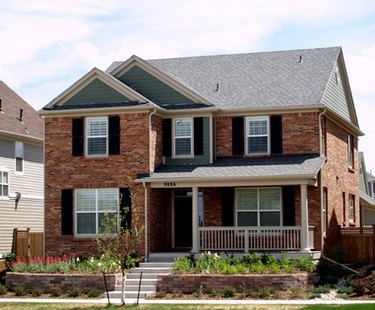
Calculating the air infiltration of a building requires a complex set of operations, but the result provides keen insight into how the building performs in terms of energy efficiency and maintenance of comfort levels. Building performance professionals use air infiltration calculations to ascertain how much air sealing should be performed on a building, how much energy can be saved and whether mechanical ventilation is needed for indoor air quality. Air infiltration of a building is also a criterion of the government's Energy Star rating system.
Step 1
Ascertain the building's air pressure with reference to outdoors by use of a blower door test. A blower door test measures the airflow necessary to pressurize a building to a specific air pressure with reference to outdoors in cubic feet per minute, referred to as cfm. The standard pressure used for this test is 50 pascals. The pascal is a standard international unit of air pressure measurement. Blower door tests are highly technical and are best performed by a building performance professional. The results of a blower door test are usually rendered in cfm50, which represents cfm of airflow at 50 pascals of pressurization.
Video of the Day
Step 2
Calculate the volume of the building in cubic feet. Calculate the volume of each room and hallway separately, and add all the results together. The method for calculating the volume of any box-shaped space is to measure and multiply the length by the width by the height to get cubic feet. There are free online volume calculators to make this easier. Most online volume calculators will also calculate the volume of other shapes such as cylinders in case there are unconventionally shaped spaces in the building. For example, if the building has just one 40-by-50-foot room with an 8-foot ceiling, the calculation would be 40 x 50 x 8 = 16,000 cubic feet.
Step 3
Divide the cfm50 by the number of cubic feet in the building. In our example, 1,800 cfm50 ÷ 16,000 cubic feet = .1125.
Step 4
Multiply the quotient of the cfm50 divided by the volume times 60 (minutes per hour) to find the air changes per hour at 50 pascals of pressure, referred to as ACH50. This is the number of times that the entire volume of air in the building will change over in one hour at 50 pascals of pressure. For example .1125 x 60 = 6.75 ACH50.
Step 5
Consult the LBL table to find the building's LBL factor. The LBL factor is determined by three criteria and is used to convert ACH50 into ACHn, or natural air changes per hour. ACHn is the standard measurement of air infiltration used by the U.S. government's Energy Star rating program as well as most of the building performance industry. The three criteria that comprise the LBL factor are climate zone, height of the building and how well shielded from wind the building is by things such as trees, shrubs and other buildings. For example, a one-story building in Austin, Texas (zone 2) that has little shielding from wind will have an LBL factor of 16.7.
Step 6
Divide the ACH50 by the LBL factor. For example, 6.75 ACH50 ÷ 16.7 LBL factor = .40 ACHn. Therefore, .40 natural air changes per hour or ACHn is the air infiltration for this building.
Warning
Beware that too little air infiltration requires mechanical ventilation to prevent serious health risks.
Video of the Day
- Energy Star: Home Sealing Specification
- Building Performance Institute: Technical Standards
- “Home Energy Magazine: Infiltration: Just ACH50 Divided by 20?"
- Math Central: Volume Calculator
- Calculator Edge: Volume Calculators
- University of California; Lawrence Berkeley Laboratory; “Air-Tightness of U.S. Dwellings”